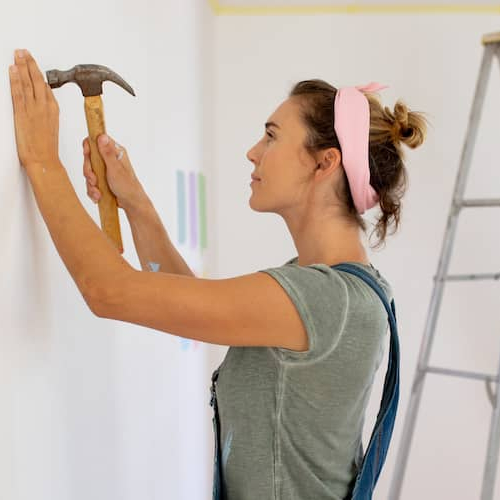USDA construction loan requirements: Everything you need to know
Contributed by Tom McLean
Aug 6, 2025
•5-minute read

As of November 16, 2025, both Fannie Mae and Freddie Mac no longer have a minimum credit score threshold in their conventional loan eligibility guidelines. Loan approval will instead be based on an evaluation of overall credit risk factors.
Building a home in a rural area? U.S. Department of Agriculture construction loans are designed to help you build and own a rural home with no down payment and a single-close loan process.
While Rocket Mortgage® doesn’t currently offer USDA construction loans, knowing how they work will help you understand your borrowing options better.
What is a USDA construction loan?
A USDA construction loan is a mortgage that low- to moderate-income borrowers can use to build homes in eligible rural areas. If the borrower defaults, the U.S. Department of Agriculture will cover the lender’s loss, lowering their risk.
USDA loans combine the cost of building the home with long-term financing into a single loan. A USDA construction-to-permanent loan simplifies the borrowing process and helps borrowers save on closing costs.
Borrower requirements for a USDA construction loan
As a borrower, you must:
- Be a U.S citizen or an eligible noncitizen.
- Have a household income at or below 115% of the area’s median income.
- Meet the lender’s minimum credit score requirement, usually 640.
- Meet the lender’s maximum debt-to-income ratio requirement, usually 41%.
Property and construction requirements
The property must:
- Be in a USDA-designated rural area. Check the USDA’s eligibility map to see if where you plan to build qualifies. Most nonurban areas do.
- Be built by a USDA-approved contractor with at least 2 years of experience. Check with your USDA-approved lender to verify whether a builder is eligible.
- Be built to U.S. Department of Housing and Urban Development standards, which you can find on the department’s website.
- Be a single-family dwelling to be occupied by the borrower when completed.
How does the USDA construction loan process work?
Here’s how to get a USDA construction loan:
- Determine your eligibility. Before you invest too much time and energy pursuing a construction loan, make sure you meet the basic requirements.
- Find a USDA-approved lender. While Rocket Mortgage no longer offers USDA loans, you can find a list of participating lenders here.
- Get prequalified. Once you’ve selected a lender, get prequalified by meeting lender-specific loan requirements.
- Select a builder. Choose a builder who has at least two years of experience and meets the licensing, insurance, and credit requirements.
- Develop a construction plan. Create a plan that details the project’s scope, timeline, cost, and location.
- Apply for the loan. Submit a loan application with your detailed construction plan to your USDA-approved lender.
- Start underwriting and approval. After reviewing your loan application, the lender will send it to the USDA for final approval.
- Close the loan. Once approved by all parties, you can proceed to closing, which covers both construction and permanent financing.
- Begin construction. Loan funds are disbursed to the builder at agreed-upon milestones as construction progresses.
- Arrange inspections. The USDA will complete a final inspection and may perform additional inspections throughout construction.
- Get a certificate of occupancy. Once the home is complete, you must request and obtain a certificate of occupancy, certifying that the property is livable.
- Convert the loan to a 30-year mortgage. Finally, the construction loan is converted into a 30-year fixed-rate mortgage.
Pros and cons
As with any loan program, USDA construction loans have their pros and cons:
Pros
- No down payment requirement. Although you can make a down payment, it’s not required with a USDA construction loan. This can make it easier for first-time home buyers and those with little savings to buy a home when compared with other loans, such as a Federal Housing Administration loan.
- Single-close process. By closing on a construction loan and a 30-year fixed mortgage at the same time, borrowers simplify financing and save on closing costs.
- Competitive interest rates. Since the USDA guarantees construction loans, lenders take on less risk and can charge lower interest rates as a result.
Cons
- Strict loan requirements. To qualify, you must earn below an income threshold, build in a rural area, and meet other loan requirements.
- Limited availability of approved lenders and builders. The USDA’s official list of participating lenders includes only 21 lenders across the U.S.
- Longer approval and construction timelines. Due to the strict loan requirements, loan approval can take longer. From there, borrowers must wait up to a year for construction.
What are alternatives to USDA construction loans?
If you want to explore other options, consider these alternatives:
USDA loan
A regular USDA loan is designed for buying an existing home. If you still want to build a house, you could get a land loan or construction loan to cover construction costs and then wrap it into a USDA rural housing loan. This gives you many of the same benefits of a USDA loan, including no down payment requirement and competitive interest rates, without having to work with a USDA-approved builder.
VA one-time close construction loan
A Veterans Affairs construction loan is available only to eligible active-duty military service members, veterans, or their surviving spouses. It offers a one-time close option that converts the construction loan into a long-term mortgage. It also offers competitive terms and no down payment requirement.
FHA one-time close construction loan
Like the USDA and VA construction loans, an FHA loan combines construction and permanent financing into a single loan and offers flexible credit requirements. However, an FHA loan requires a down payment of at least 3.5% and requires mortgage insurance.
Conventional one-time close construction loan
You always can apply for a conventional one-time close construction loan. This is best for borrowers with strong credit and a stable income since the loan requirements tend to be stricter. For example, most lenders require a down payment of at least 20% and a minimum credit score of 620. However, you’ll also have more lenders and builders to choose from.
FAQ
Here are answers to common questions about USDA construction loans.
Can I use a USDA construction loan for a manufactured home?
Yes, USDA construction loans can generally be used for a manufactured home if it has a permanent foundation. This can be an inexpensive way to build an affordable house.
Can I act as my own builder?
No, USDA loans do not allow for owner-builders. However, if you are a USDA-approved builder by profession, you can use your construction company to build your home with a USDA loan.
What happens if construction costs exceed the loan amount?
If construction costs exceed the loan amount, the borrower must make up the difference with their own funds.
The bottom line: USDA construction loans can simplify the financing process
USDA construction loans can make your rural home-building dreams come true. With no down payment requirement, a USDA single-close loan process, and competitive interest rates, these loans are an attractive option for low- to moderate-income households.
If you think a USDA construction loan might be right for you, connect with a USDA-approved lender to explore your options and begin the application process today.

Christian Allred
Christian Allred is a freelance writer whose work focuses on homeownership and real estate investing. Besides Rocket Mortgage, he’s written for brands like PropStream, CRE Daily, Propmodo, PropertyOnion, AIM Group, Vista Point Advisors, and more.
Related resources
8-minute read
Is it cheaper to build or buy a house? What you need to know
Wondering if it’s cheaper to buy or build a house? Discover the costs of building a house versus buying and which option is more suitable for your fina...
Read more

7-minute read
Cheapest ways to build a house: 12 tips for affordable home building
Building a home can be a viable option for buyers in a competitive market, but expenses can add up quickly. Discover the cheapest ways to build a house.
Read more
6-minute read
10 best places to build a house during the 2021 building boom
Are you interested in building a house on a budget? Learn about the 10 cheapest places to build a house in 2023 and other factors to consider when building.
Read more